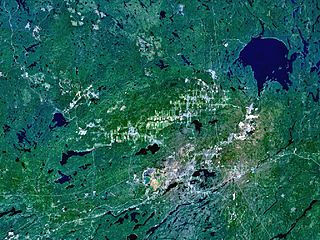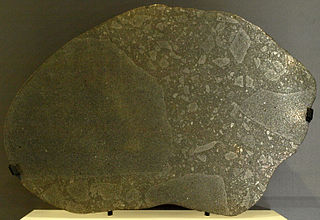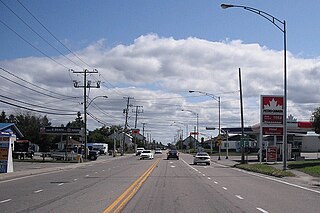
Meteor Crater is a meteorite impact crater approximately 37 miles (60 km) east of Flagstaff and 18 miles (29 km) west of Winslow in the northern Arizona desert of the United States. Because the United States Board on Geographic Names commonly recognizes names of natural features derived from the nearest post office, the feature acquired the name of "Meteor Crater" from the nearby post office named Meteor. The site was formerly known as the Canyon Diablo Crater and fragments of the meteorite are officially called the Canyon Diablo Meteorite. Scientists refer to the crater as Barringer Crater in honor of Daniel Barringer, who was first to suggest that it was produced by meteorite impact. The crater is privately owned by the Barringer family through their Barringer Crater Company, which proclaims it to be the "best preserved meteorite crater on Earth". Despite its importance as a geological site, the crater is not protected as a national monument, a status that would require federal ownership. It was designated a National Natural Landmark in November 1967.

The Sudbury Basin, also known as Sudbury Structure or the Sudbury Nickel Irruptive, is a major geological structure in Ontario, Canada. It is the third-largest known impact crater or astrobleme on Earth, as well as one of the oldest. The crater formed 1.849 billion years ago in the Paleoproterozoic era.

The Pingualuit Crater, formerly called the Chubb Crater and later the New Quebec Crater, is a young impact crater, by geological standards, located on the Ungava Peninsula, in the administrative region of Nord-du-Québec, in Quebec, Canada. It is 3.44 km (2.14 mi) in diameter, and is estimated to be 1.4 ± 0.1 million years old (Pleistocene). The crater and the surrounding area are now part of Pingualuit National Park. The only species of fish in the crater lake is the arctic char.

René-Levasseur Island is a large island in the centre of Lake Manicouagan in Quebec, Canada. Its highest peak is Mount Babel, at 952 m, which is contained in the Louis-Babel Ecological Reserve. With a total area of 2,020 km², the island is larger in area than the annular lake in which it is situated. René-Levasseur Island is the world's second largest lake island.

Albert Peter Low was a Canadian geologist, explorer and athlete. His explorations of 1893–1895 were important in declaring Canada's sovereignty over the Arctic, and eventually defining the border between Quebec and Labrador.

The Ottawa-Bonnechere Graben is a geological structure that coincides with a 55 km (34 mi) wide topographic depression extending from near Montréal through Ottawa. It is part of the St. Lawrence rift system that also includes the seismically active Saguenay graben. This rift valley was formed when the Earth's crust moved downward about a kilometre between two major fault zones known as the Mattawa and Petawawa faults. The length of the graben is about 700 km (435 mi).

Enstatite chondrites are a rare form of meteorite thought to comprise only about 2% of the chondrites that fall on Earth. Only about 200 E-Type chondrites are currently known.

The Western Quebec Seismic Zone is a seismically active area in the Ottawa Valley in Eastern Ontario and Western Quebec. The zone stretches from Montreal to Témiscaming and from Cornwall up along the Laurentian Mountains.

The 2010 Central Canada earthquake occurred with a moment magnitude of 5.0 in Central Canada on 23 June at about 13:41:41 EDT and lasted about 30 seconds. The epicentre was situated in the area of Buckingham, Quebec, approximately 56 kilometres (35 mi) north of Ottawa, Ontario, closest to the settlement of Val-des-Bois, Quebec. Canada's capital, Ottawa, declared this earthquake as being its most powerful in 65 years.
St-Robert is an ordinary chondrite meteorite fell on Quebec on June 14, 1994.
Lac Dodon is an iron meteorite discovered by Roland Octerneau of Montreal on rural private property near Lac Dodon, Saint-Calixte, Quebec.

Elbogen, also the Loket Iron, is an iron meteorite that fell in the village of Loket, Karlovy Vary Region, Kingdom of Bohemia, about the year 1400. Also known during the Middle Ages as the "bewitched burgrave" of Elbogen, due to a cursed Count at the Elbogen castle, it is the oldest of 15 recorded falls in the Czech Republic. It has not survived to our time in its original size, having been cut for scientific purposes and its pieces sent to museums all around the world.
Annaheim is an iron meteorite recovered in 1916 in Canada.
Benton is a meteorite found near the village of Benton, New Brunswick following a fireball. Two masses were found but the meteorites were split up. The largest fragment is now in the Canadian National Meteorite Collection, Ottawa.
The Blithfield meteorite was found by Mr. Joseph Legree in Blithfield Township, Renfrew County, Ontario and measured about 8 centimetres (3.1 in) x 10 centimetres (3.9 in) x 13.5 centimetres (5.3 in). The main mass is now in the Canadian National collection, Ottawa. Blithfield is an enstatite chondrite, a group of very unusual meteorites that were formed in a very reducing atmosphere. It is a breccia, one of only five known enstatite chondrite breccias.
Gay Gulch is an iron meteorite found in 1901 by miners near Dawson City, Yukon Territory, using a slice box to mine alluvial gold. They were exploiting Pliocene gravel, hence the meteorite may have fallen at that time.

The Champlain Sea was a temporary inlet of the Atlantic Ocean, created by the retreating glaciers during the close of the last ice age. The Sea once included lands in what are now the Canadian provinces of Quebec and Ontario, as well as parts of the American states of New York and Vermont.

The Treysa Meteorite, also known as the Rommershausen Meteorite, is an astronomical relic found in a wooded area near the Rommershausen district of Schwalmstadt in northern Hesse, Germany. The meteorite made German astronomical history as one of the most significant confirmed meteorite collisions of recent history. It is classified as a medium octahedrite of the IIIB chemical class and shows Widmanstätten patterns.

The Presqu'île Lake is a body of water forming a lake at 5.4 kilometres (3.4 mi) South of the center of the village Chapais, in the regional County Municipality (RCM) of Eeyou Istchee Baie-James, in the administrative region of Nord-du-Quebec, in Quebec, in Canada. This body of water straddles the townships of Lévy, de Brongniart, and Brochant.















